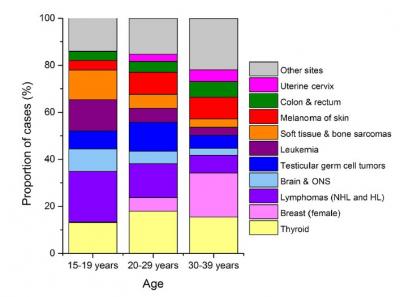Press Releases

A new report examining cancer in adolescents and young adults (AYAs), defined as diagnoses occurring during ages 15 to 39, provides updated estimates of the contemporary cancer burden in this age group, predicting that 89,500 cases and 9,270 deaths will occur in 2020 in the United States. The report appears in the American Cancer Society journal: CA: A Cancer Journal for Clinicians.
AYAs with cancer are frequently grouped with older or younger patient populations and/or presented in aggregate, masking the wide heterogeneity in cancer occurrence within this population. To address this issue, American Cancer Society investigators also examined cancer incidence, survival, and mortality among AYAs by race/ethnicity and for smaller age groups (15-19, 20-29, and 30-39).
Cancer incidence rates among AYAs are highest in those who are non-Hispanic white (83 per 100,000 population during 2012-2016) and lowest in those who are Asian/Pacific Islander (54 per 100,000 population) for both sexes. This reflects higher rates in non-Hispanic white AYAs for thyroid cancer, testicular tumors, and melanoma compared to other major racial/ethnic groups. Unlike adults ages 40 and older, however, female breast cancer incidence rates in non-Hispanic Black AYAs are 14% higher than those in non-Hispanic white AYAs (25.9 vs 22.3 per 100,000 population).
The authors also note that despite patterns in overall incidence, cancer mortality rates are highest in non-Hispanic Black AYAs, particularly females (12.6 per 100,000 vs 9.2 in non-Hispanic white persons), reflecting substantial survival disparities compared to those who are non-Hispanic white. The largest 5-year cancer-specific survival disparities occur among those who are non-Hispanic Black compared with non-Hispanic whites for acute lymphocytic leukemia (57% vs 71%, respectively) and female breast cancer (78% vs 89%, respectively).
By age group, the cancer incidence rate in AYAs increased during the most recent decade (2007-2016) overall but showed signs of stabilizing among men in their 20s. The rise is largely driven by thyroid cancer incidence rates, which rose by approximately 3% annually among those aged 20 to 39 and 4% among those aged 15 to 19 years. Incidence increased for several cancers linked to obesity, including kidney (3% across all age groups), uterine corpus (3% in group aged 20-39 years), and colorectum (0.9%-1.5% in the group aged 20-39 years).
In contrast to incidence, cancer mortality rates among AYAs for all cancers combined declined in the past decade (2008 through 2017) by 1% across sex and age groups except females aged 30 to 39, among whom rates remained stable due to a flattening of declines in breast cancer mortality. Mirroring incidence, mortality rates increased during the most recent 10 data years (2008-2017) for colorectal and uterine corpus cancers.
Other highlights from the report include:
- Adolescents (aged 15-19 years) are more likely to be diagnosed with cancers associated with childhood, such as Hodgkin lymphoma, while those aged 20 to 39 years are more likely to be diagnosed with adult cancers, such as breast. Thyroid cancer is the only cancer predicted to rank among the three most commonly diagnosed cancers in each AYA age group in 2020.
- Leukemia continues to be the leading cause of cancer death in ages 15 to 29 years. Among ages 30-39 years, breast (women) and colorectal (men) cancers are the leading cancer causes of death.
- Melanoma incidence rates during 2007-2016 rapidly declined in ages 15 to 29 (4%-6% annually, on average). However, among ages 30-39 years, rates declined only slightly among men and remained flat among women.
- Overall 5-year relative survival in AYAs for all cancers combined (83%-86% across age groups) is similar to that in children (84%), but masks lower survival for several cancer types, such as acute lymphocytic leukemia (ALL; 60% vs 91%, respectively).
The report notes an increasing body of evidence that tumors in AYAs are molecularly distinct from those in younger or older populations, suggesting differences in etiology and in treatment options. In addition, studies have shown that compared to childhood cancer survivors, AYAs have a higher risk of progression and death from their original cancer. Compared to older cancer patients, AYAs have a higher risk of long-term and late effects including infertility, sexual dysfunction, cardiovascular disease, and other future cancers. However, further research in these areas is needed.
The authors say that progress in reducing cancer morbidity and mortality among AYAs could be improved with more equitable access to health care, as AYAs are more likely than other age groups in the U.S. to be uninsured. Increased clinical trial enrollment, expanded research, and improved awareness among clinicians and patients of early symptoms and signs of cancer could also accelerate progress.
“Although there has been rapid progress in the scientific understanding of cancer in AYAs over the last decade, several research gaps in etiology, basic biology, treatment, and survivorship remain,” write the authors. “AYAs diagnosed with cancer also continue to face challenges in health care access during early life transitions, which can negatively impact treatment.”
Article: Miller KD, Fidler-Benaoudia M, Keegan TH, Hipp HS, Jemal A, Siegel RL. Cancer Statistics for Adolescents and Young Adults, 2020. CA Cancer J Clin 2020; doi: 10.3322/caac.21637.
URL upon embargo: http://onlinelibrary.wiley.com/doi/full/10.3322/caac.21637